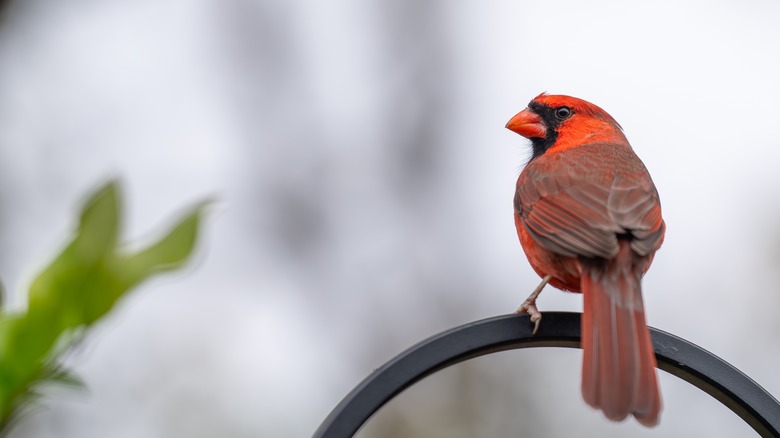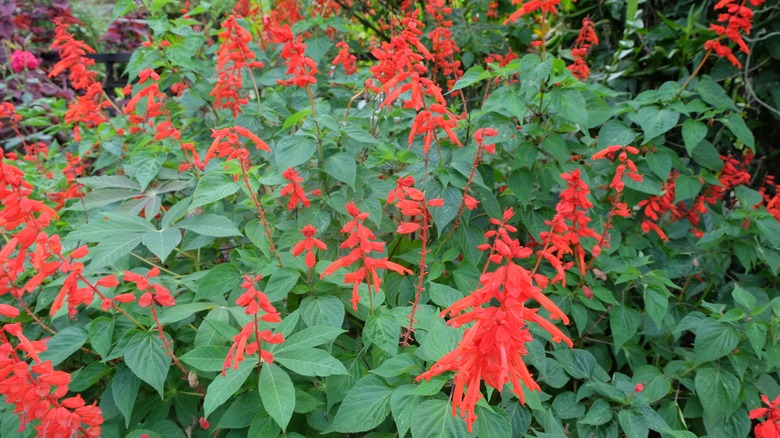Attracting Cardinals Is Easier When You Grow This Perennial That They Love
Is there anything quite as magical as spotting a beautiful, brilliantly red cardinal flying and flitting about in your garden? These gorgeous birds are a pure joy to watch and, to many, a symbol of luck or even a visit from a loved one. There's no wonder why, then, so many people go to great lengths to attract more cardinals to their yards, doing everything from setting up bird feeders to making sure they always have fresh water available or creating cozy, well-protected shelters for them.
But beyond these typical measures, there is yet one more way you can draw cardinals into your garden — planting native flowers that cater to their specific tastes! Among these native options, one perennial stands out for its particular appeal to cardinals — the scarlet sage. Also known as Salvia coccinea, this plant is a beautiful splash of color for your garden that also serves as a magnet for cardinals and other bird species. Native plants are a real bonus for backyards everywhere. Not only are native plants well-suited to the local climate and soil conditions and thus often a bit easier to maintain, but they also provide natural habitats and food sources for local critter populations (such as cardinals.)
How does scarlet sage attract cardinals?
When it comes to backyard beauties that will bring all the cardinals to your yard, scarlet sage is a perennial that originates from the sun-drenched regions of the southeastern United States. It has also made itself at home in other warm climates across the globe. This plant is a feast for the eyes, boasting bright red tubular flowers that stand tall on slender stems, surrounded by particularly green and lush leaves.
But what makes scarlet sage particularly appealing to cardinals? Well, it could be that the vibrant red flowers are a color that is attractive to birds in general. The flower is also rather bushy and thick with leaves, which cardinals like for building nests in and hiding from predators. It might also be that scarlet sage is particularly good at attracting insects, particularly butterflies and other small, nectar-loving bugs, which cardinals will feast on for extra protein. All in all, while not a major source of seeds like some other perennials, these flowers are still the perfect choice for attracting cardinals to your garden.
How do you plant and grow scarlet sage?
Sold on scarlet sage? Good, but now you may be wondering where you plant this bird-friendly beauty. The good news is that scarlet sage thrives in sunny locations with well-drained soil in zones 8 through 10. Choose a spot in your garden that receives plenty of sunlight throughout the day and where the soil drains particularly well.
When planting scarlet sage, start with young plants or seeds, spacing them about 12 to 18 inches apart so each gets all the air circulation that they need to grow. Water the newly planted sage regularly, especially during dry spells, to help it establish strong roots. Once established, scarlet sage is relatively low-maintenance, requiring moderate watering and occasional pruning to remove spent flowers and promote fresh growth.
One thing to keep in mind is that patience is key when waiting for your scarlet sage to bloom. Depending on the growing conditions and the time of planting, it typically takes a few weeks to several months for the plant to begin flowering. However, it does bloom from late spring throughout the summer and into early fall as long as it is warm and has been watered enough. Pair with other perennials, particularly ones with seeds that cardinals like, such as sunflowers and zinnias, and you'll bring more cardinals to your yard in no time.


